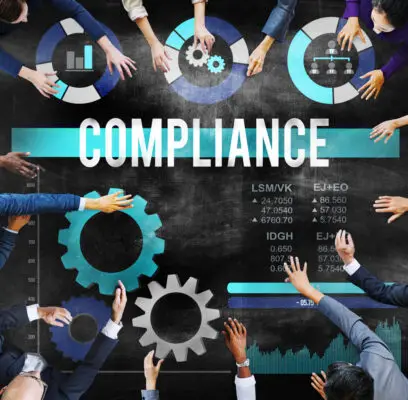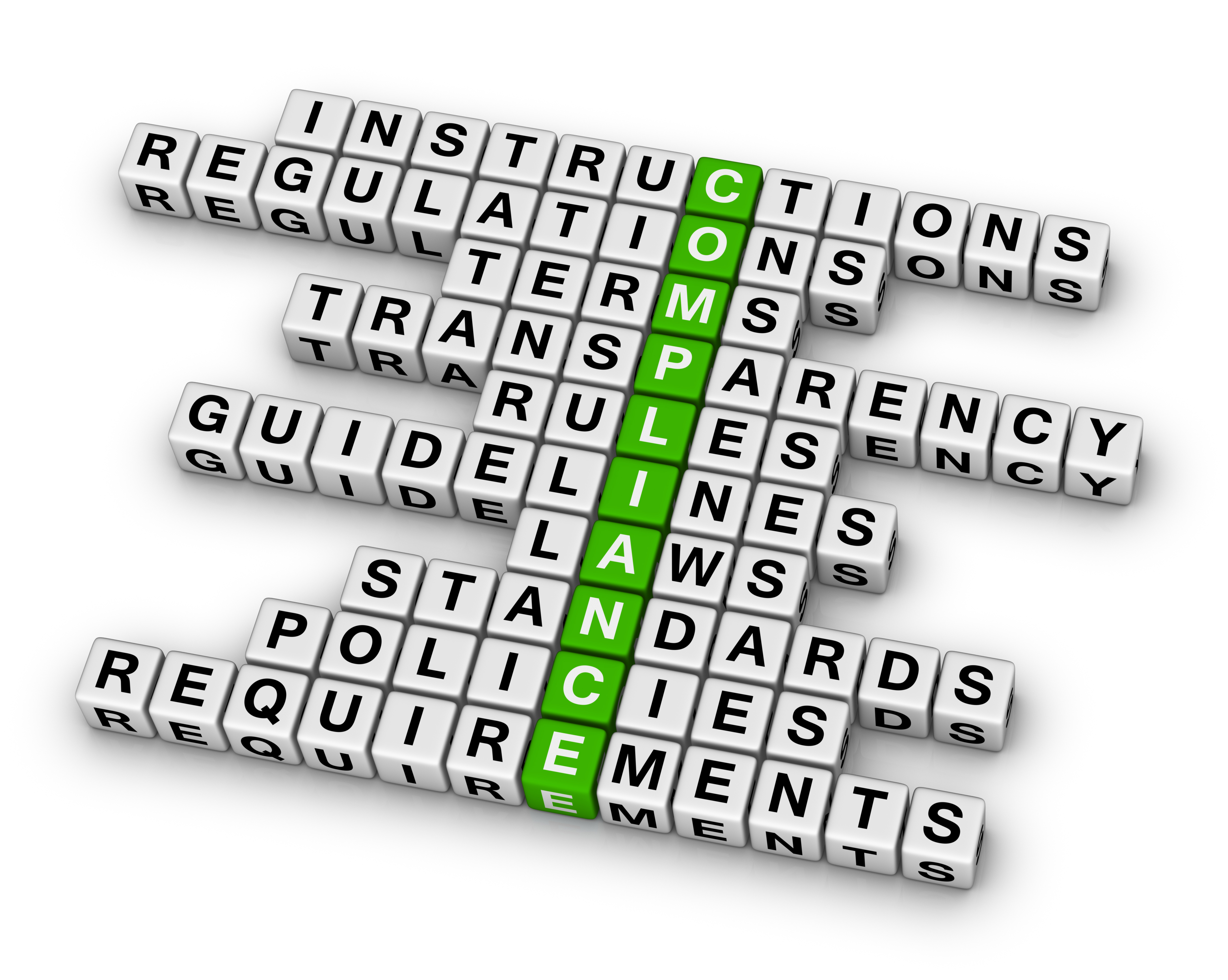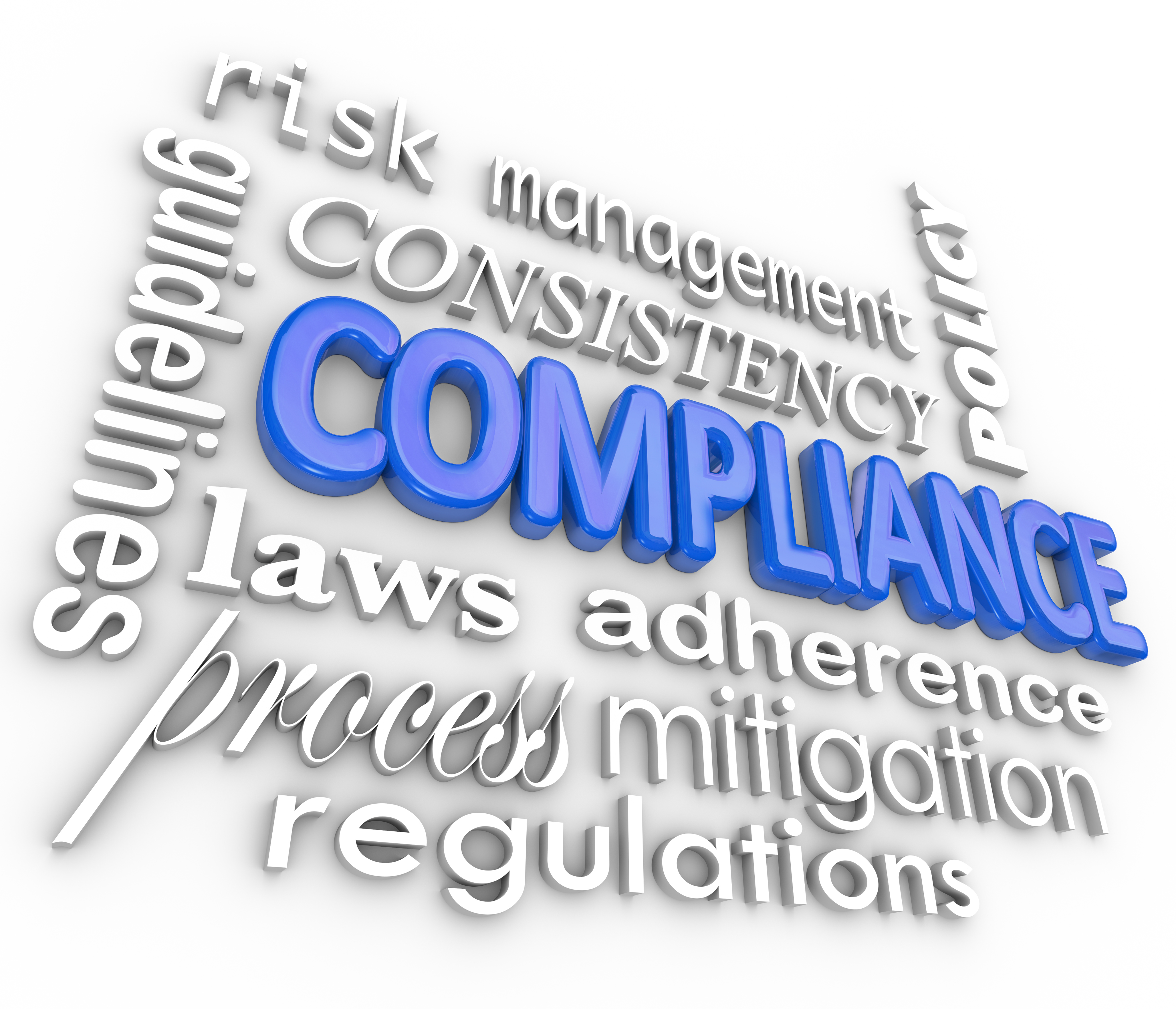Compliance management involves developing policies and procedures that ensure a company follows all legal requirements, ethical guidelines, and internal controls.
Compliance management programs are designed to help companies comply with regulations in every area of their operations. This includes financial compliance, protection of data and privacy, and maintaining health, safety, and environmental compliance.
The goal is to develop comprehensive plans that mitigate risks associated with non-compliance while ensuring organizational goals are met in a timely manner.
Businesses must be proactive in their approach towards compliance management, as regulatory environments can change quickly, leaving them exposed if they do not have effective systems in place.

Understanding Compliance Management
Systematic adherence to regulatory requirements and ethical principles is critical to organizational governance. Compliance management is the process that enables organizations to adhere to these guidelines, ensuring legal and regulatory requirements are met while minimizing risks.
Compliance Risk Assessment: This is the process of identifying and assessing the potential risks arising from non-compliance. This could include financial penalties, legal consequences, reputational damage, and operational disruptions.
Policy Development and Implementation: Compliance management involves creating and implementing policies that guide the organization’s compliance efforts. These policies should be clear, comprehensive, and communicated effectively to all relevant parties.
Training and Education: Employees at all levels of the organization need to understand the importance of compliance and their role in ensuring it. This often involves regular training and education sessions.
Monitoring and Auditing: Regular monitoring and auditing are essential to ensure the organization follows all compliance policies and procedures. This often involves internal audits, as well as external audits in some cases.
Reporting and Documentation: Compliance management should include a system for reporting potential compliance issues and documenting all compliance efforts. This can be critical for demonstrating compliance with regulators, auditors, or other stakeholders.
Remediation: If compliance issues are identified, the organization needs to take steps to address them. This could involve revising policies, retraining employees, or even disciplinary action in some cases.
Continuous Improvement: Compliance is not a one-time effort but an ongoing process. Organizations must continually review and improve compliance management efforts, especially as regulations and business environments change.
Organizations must develop and implement effective compliance management programs that ensure compliance with laws, regulations, policies, and procedures.
Regulatory requirements are the foundation for any compliance management program. These guidelines outline the rules organizations must follow to operate within the law.
Failure to comply with these requirements can result in severe penalties and damage to an organization’s reputation. The risk of non-compliance can be mitigated by implementing a comprehensive risk management strategy that identifies potential areas of non-compliance and sets out measures to reduce or eliminate such risks.
Effective compliance management requires a coordinated effort across all levels of an organization. It involves identifying potential areas of risk and developing policies and procedures to prevent non-compliance.
Monitoring adherence to those policies, training employees on proper protocols, conducting regular internal audits, and reporting violations internally and externally, where required by law.
An effective compliance program minimizes risks and helps protect the organization’s reputation by demonstrating its commitment to ethical practices and good corporate citizenship.
Developing a Compliance Management Program
Developing a compliance management program involves establishing policies and procedures, training employees, and implementing compliance monitoring systems.
Policies and procedures must be clear, concise, and tailored to the organization’s needs to ensure effective compliance management.
Training employees on these policies is crucial for understanding how to comply with regulations.
Implementing compliance monitoring systems ensures organizational activities align with established policies and regulations.
Establishing Policies and Procedures
Establishing clear policies and procedures is crucial for effectively navigating the intricate web of regulations and guidelines that organizations must adhere to avoid legal consequences and ensure ethical business practices.
Policy implementation involves creating written rules that outline specific actions or behaviors that employees must follow. Compliance documentation, on the other hand, refers to recording and maintaining records of adherence to these policies over time.
To establish effective policies and procedures, involving relevant stakeholders such as employees, management, legal advisors, and compliance professionals is essential.
These stakeholders can provide valuable input on gaps in existing policies or areas where new policies may be necessary.
Once policies have been developed, they should be communicated to all employees through training programs or other means. Additionally, regular reviews should be conducted to ensure that policies remain up-to-date with changing laws and regulations.
Finally, compliance documentation should be kept up-to-date with all policy changes to ensure an accurate record of adherence over time.
Training Employees
Training employees is critical to ensuring organizational success, as it equips them with the necessary skills and knowledge to perform their duties effectively and efficiently.
Compliance management involves establishing policies and procedures that comply with regulations, but training employees on these policies is equally important.
Employees need to understand why compliance is essential, how it affects their work, and what they can do to ensure compliance. Employee engagement is crucial for effective training.
Engaged employees are more likely to retain information, apply what they have learned, and contribute positively to the organization’s culture of compliance.
Compliance culture refers to an environment where everyone understands the importance of complying with regulations and takes responsibility for doing so. Effective training plays a significant role in creating a compliance culture by instilling the values of ethical behavior and regulatory adherence within employees.
Therefore, organizations must invest in continuous training programs that keep their workforce updated on new rules and regulations while reinforcing a strong culture of compliance.

Implementing Compliance Monitoring Systems
Implementing compliance monitoring systems is critical to ensuring regulatory adherence and maintaining organizational integrity. These systems provide the necessary checks and balances to ensure that policies and procedures are followed, risks are identified and managed, and any deviations or violations are promptly addressed.
Compliance monitoring systems typically involve automated tools that monitor vital areas such as financial transactions, data security, human resources practices, and environmental impact.
Cost analysis is an important consideration when implementing compliance monitoring systems. Organizations need to weigh the cost of implementing such systems against the potential benefits gained from improved regulatory adherence and reduced risk exposure.
This includes not only the cost of purchasing software or other technological tools but also the cost of training staff on how to use them effectively.
Additionally, organizations must stay up-to-date with regulatory updates to ensure that their compliance monitoring systems remain relevant and effective over time.
In short, while it may require time and resources upfront, implementing a robust compliance monitoring system can ultimately benefit an organization’s bottom line by reducing legal fees associated with non-compliance incidents or penalties.
Ensuring Financial Compliance
Navigating the complex web of financial regulations can be compared to carefully weaving a tapestry. To create a cohesive and compliant piece, each thread must be placed with precision and attention to detail.
Ensuring financial compliance is critical to compliance management, as it involves adhering to regulatory requirements that govern financial activities.
Organizations must conduct regular risk assessments, develop policies and procedures, and implement monitoring systems to identify and mitigate potential risks to achieve this.
One key aspect of ensuring financial compliance is managing transactions effectively. Organizations must ensure that their accounting practices are accurate, transparent, and comply with relevant reporting standards.
This includes maintaining comprehensive records of all transactions, conducting regular audits, and providing timely reports on financial performance. Failure to do so can result in costly penalties or reputational damage.
Another essential part of ensuring financial compliance is staying up-to-date with changing regulations. Regulatory requirements constantly evolve in response to new risks or developments in the industry.
As such, organizations must invest in ongoing training for employees who handle financial transactions and maintain strong communication channels with regulatory bodies.
Protecting Data and Privacy
Data security protects digital data from theft, damage, or unauthorized access.
Regulatory compliance is essential to ensuring data security since it involves adhering to laws and regulations governing how organizations handle sensitive information.
Organizations must establish comprehensive data security policies and procedures that align with regulatory requirements such as GDPR (General Data Protection Regulation) and HIPAA (Health Insurance Portability and Accountability Act).
This includes implementing robust authentication protocols, encrypting sensitive data during transmission and storage, regularly monitoring network activity for any suspicious behavior, and conducting regular vulnerability assessments.
Failure to comply with these regulations can lead to hefty fines, legal penalties, loss of business reputation, and customer trust.
In conclusion, protecting data and privacy is a significant challenge for organizations due to the increasing number of cyber threats targeting sensitive information.
To mitigate these risks effectively, organizations must establish robust measures to safeguard their digital assets while complying with regulatory requirements.
Maintaining Health, Safety, and Environmental Compliance
Maintaining health, safety, and environmental standards is critical to organizational operations that protect employees, customers, and the environment.
According to the Occupational Safety and Health Administration (OSHA), workplace injuries and illnesses cost US employers over $170 billion annually. Therefore, organizations must prioritize compliance management to prevent accidents and ensure regulatory compliance.
One way to maintain health, safety, and environmental compliance is through employee training. Organizations should provide regular training sessions on hazard identification, emergency response procedures, and the proper use of personal protective equipment.
This helps prevent accidents and ensures that employees are aware of their responsibilities regarding maintaining compliance.
Regulatory agencies ensure that organizations maintain health, safety, and environmental compliance. These agencies set standards for workplace safety and monitor organizations’ adherence to these standards through inspections and audits.
Failure to comply with regulations can result in fines or legal action against an organization. Therefore, organizations must stay up-to-date with regulatory requirements to avoid penalties or reputational damage associated with non-compliance.
Frequently Asked Questions
How does compliance management differ from risk management?
Compliance and risk management are two distinct concepts, though they are similar. Risk mitigation is focused on identifying potential risks to an organization and taking steps to reduce or eliminate those risks.
Regulatory compliance, on the other hand, involves ensuring that an organization adheres to relevant laws and regulations. Compliance management is therefore concerned with monitoring and enforcing adherence to these rules.
While compliance and risk management are essential for organizations, their objectives differ significantly.
Compliance management is primarily aimed at avoiding legal liability, while risk management aims to minimize the impact of potential risks on an organization’s operations.
Effective implementation of compliance and risk management strategies is critical for achieving long-term organizational success.
Are there any legal consequences for non-compliance with regulations?
Failing to comply with regulations can have serious legal consequences. Non-compliance may result in fines, penalties, or other enforcement actions.
These legal ramifications can be severe and are designed to deter organizations from violating regulatory requirements.
The penalties for non-compliance can vary depending on the industry and specific regulations violated.
What are the key components of a successful compliance management program?
These include comprehensive training programs covering all relevant regulations and policies and ongoing education for employees to stay up-to-date with any changes or updates.
Additionally, effective performance metrics should be established to monitor the success of the compliance program, including regular audits and risk assessments.
Strong communication channels between management and staff are vital to ensure everyone is working towards the same goals and objectives.
How can technology be used to enhance compliance management efforts?
Implementing technology can help organizations automate mundane tasks, monitor regulatory changes and identify potential risks before they occur.
However, implementing technology solutions for compliance management is not without challenges. One major challenge is acquiring and maintaining such systems, which may be prohibitively expensive for many organizations.
Additionally, a learning curve may be associated with adopting new technologies that require significant training and support from IT personnel.
Despite these challenges, the benefits of implementing technology solutions far outweigh the costs. It enables organizations to streamline compliance processes and stay ahead of regulatory requirements while minimizing risks.
Can compliance management help improve business operations beyond just meeting regulatory requirements?
Compliance management ensures that the company operates within legal boundaries and helps establish best practices for data security, quality control, and ethical conduct.
This focus on compliance can ultimately lead to a competitive advantage as customers are more likely to trust and do business with companies that prioritize compliance and ethical behavior.

Conclusion
Compliance management is critical to any organization’s operations as it ensures the company adheres to regulatory requirements, industry standards, and internal policies.
Developing a compliance management program requires identifying potential risks and implementing measures to mitigate them.
Financial compliance is essential for companies to avoid legal penalties, fines, and damage to their reputation. Protecting data and privacy is also crucial in today’s digital age, where cyber threats are rampant.
Finally, maintaining health, safety, and environmental compliance safeguards employees’ well-being while minimizing the company’s environmental impact.
Compliance management is integral in promoting accountability and ethical behavior within organizations. It helps businesses operate within legal frameworks while fostering trust between stakeholders such as customers, investors, regulators, and employees.
Failure to comply with regulations can lead to severe consequences, such as lawsuits or revocation of licenses that can negatively affect long-term profitability.
Therefore, companies must prioritize compliance management by investing in training programs for employees at all levels of the organization. In conclusion, effective compliance management is essential for organizations looking to succeed in today’s complex business environment.
A single violation or non-compliance issue could potentially cause significant harm to a company’s reputation and bottom line. Therefore businesses must take proactive measures toward building robust compliance frameworks that safeguard against potential risks of non-compliance
Implementing various strategies like regular audits or risk assessments; will allow them to survive and thrive among competitors while ensuring they stay legally compliant at all times.

Chris Ekai is a Risk Management expert with over 10 years of experience in the field. He has a Master’s(MSc) degree in Risk Management from University of Portsmouth and is a CPA and Finance professional. He currently works as a Content Manager at Risk Publishing, writing about Enterprise Risk Management, Business Continuity Management and Project Management.

